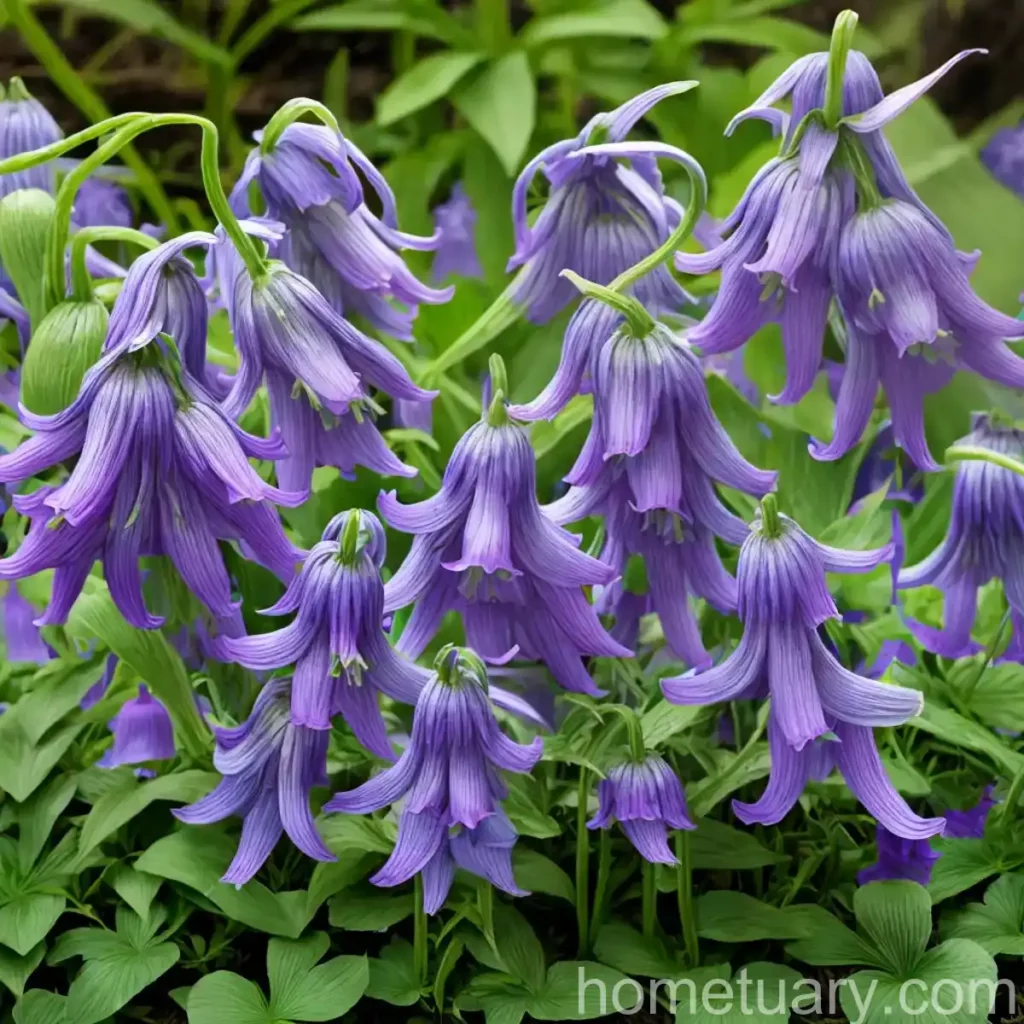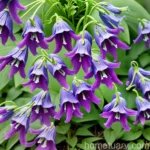bluebell (Campanula rotundifolia): A Beautiful Addition to Your Garden
Bluebells, scientifically known as Campanula rotundifolia, are delicate and enchanting plants that add charm to any garden. With their stunning blue, bell-shaped flowers and graceful demeanor, they are a popular choice for many gardeners. In this comprehensive guide, we will delve into the captivating world of bluebells, discussing everything from their cultural significance to their care requirements, propagation, common diseases, and much more.
What is bluebell (Campanula rotundifolia)?
Bluebells, or Campanula rotundifolia, belong to the Campanulaceae family and are native to many parts of the Northern Hemisphere, including Europe, Asia, and North America. The plant is also commonly known as harebell, bluebell of Scotland, or the witches’ thimble. Bluebells are herbaceous perennial plants that produce slender stems with blue, bell-shaped flowers at their tips. These flowers often sway gently in the breeze, adding a sense of tranquility to any garden or natural setting.
Key Takeaways – Bluebell (Campanula rotundifolia)
Before we dive into the specifics of bluebell care and cultivation, let’s take a quick look at some key takeaways about this delightful plant:
- Scientific Name: Campanula rotundifolia
- Family: Campanulaceae
- Common Names: Bluebell, harebell, bluebell of Scotland, witches’ thimble
- Plant Type: Herbaceous perennial
- Flower Color: Blue, occasionally white
- Native Habitat: Europe, Asia, North America
- Special Features: Bell-shaped flowers, delicate foliage
Now that we have an overview of bluebells, let’s explore the cultural significance, uses, and care requirements for this captivating plant.
Culture
Understanding the cultural significance and uses of bluebells can provide a deeper appreciation for this beautiful species and its unique place in horticulture and folklore.
Uses
Bluebells have been revered for their aesthetic beauty and have been a part of various cultural traditions and practices for centuries. Here are some common uses and symbolic associations of bluebells:
- Gardening: Bluebells are widely used in garden borders, rock gardens, and naturalized settings to add a touch of elegance and color.
- Medicinal: In folklore, bluebells were believed to have various medicinal properties, although no scientific evidence supports these claims. They were often used in traditional herbal remedies for ailments such as coughs and heart conditions.
- Symbolism: Bluebells are often associated with themes of gratitude, humility, and everlasting love. In some cultures, they symbolize constancy and are used to convey messages of trust and faithfulness.
Water
Bluebells thrive in moderately moist soil and prefer well-draining conditions. They can tolerate occasional dry spells but perform best when the soil remains consistently moist, especially during the growing season. Overly wet or waterlogged soil can lead to root rot, so it’s essential to strike a balance when watering bluebells.
- Watering Tips:
- Water bluebells when the top inch of the soil feels dry to the touch.
- Avoid overwatering, especially during periods of dormancy, as this can lead to root issues.
- Mulching around the base of the plants can help retain soil moisture and reduce the frequency of watering.
Sunlight
Bluebells exhibit a preference for partial to full sunlight. While they can tolerate some shade, they thrive in locations with ample sunlight, which promotes robust growth and abundant flowering.
- Sunlight Requirements:
- Plant bluebells in areas that receive at least 6-8 hours of sunlight per day.
- In hotter climates, they may benefit from some afternoon shade to protect them from intense midday sun.
- Ensure that the plants have access to dappled sunlight for a portion of the day for optimal performance.
Fertilizer
Bluebells are relatively low-maintenance when it comes to fertilization. However, a light application of a balanced, slow-release fertilizer in early spring can support healthy growth and blooming.
- Fertilizer Guidelines:
- Use a balanced fertilizer with an N-P-K ratio of 10-10-10 or similar, applying it according to the manufacturer’s instructions.
- Avoid over-fertilizing, as this can lead to excessive foliage growth at the expense of flowering.
- A single annual application in spring should provide adequate nutrition for bluebells throughout the growing season.
Soil
The type of soil in which bluebells are planted plays a crucial role in their overall health and vitality. Well-draining, loamy soil with a slightly acidic to neutral pH is ideal for these plants.
- Soil Recommendations:
- Amend heavy clay soil with organic matter, such as compost or peat moss, to improve drainage and aeration.
- Bluebells thrive in soil with a pH ranging from 5.5 to 7.0, which supports nutrient uptake and overall plant vigor.
- Avoid overly compacted or waterlogged soil, as this can lead to root suffocation and decline.
Pruning
Pruning bluebells is a relatively simple task that primarily involves the removal of spent flowers and the occasional tidying of the plant’s foliage. Proper pruning practices can help maintain the plant’s shape and encourage additional blooming.
- Pruning Guidelines:
- Deadhead faded flowers regularly to promote continuous blooming and prevent the plant from expending energy on seed production.
- Use clean, sharp pruners to remove spent flower stems at their base, taking care not to damage the surrounding foliage.
- In late fall, after the plants have gone dormant, remove any yellowing or withered foliage to keep the planting area neat and prepare the plants for the coming growing season.
Propagation
Bluebells can be propagated through several methods, including division, seed sowing, and stem cuttings. Each approach has its benefits and considerations, allowing gardeners to expand their bluebell collection with ease.
- Propagation Techniques:
- Division: Dividing established bluebell clumps in early spring or fall can yield additional plants with minimal effort. Carefully separate the rhizomes or offsets and transplant them into prepared soil.
- Seed Sowing: Collecting and sowing bluebell seeds in the fall can yield new plants in the following growing season. Sow the seeds in shallow containers or directly in the garden bed for optimal results.
- Stem Cuttings: Taking stem cuttings from healthy bluebell plants in late spring or early summer can result in new plants with identical characteristics. Root the cuttings in a moist, well-draining medium and provide them with gentle bottom heat to encourage root development.
Container Popularity
Bluebells are well-suited to container cultivation, offering a graceful and charming presence in various outdoor and indoor settings. Their adaptability makes them an excellent choice for container gardening enthusiasts.
- Container Considerations:
- Select a large, well-draining container with ample drainage holes to provide optimal growing conditions for bluebells.
- Fill the container with a high-quality, well-aerated potting mix that mimics the preferred soil conditions for bluebells, ensuring proper moisture retention and nutrient levels.
- Place the container in a location that receives adequate sunlight, and monitor the soil moisture regularly to prevent over- or underwatering.
Common Diseases
While bluebells are generally resilient plants, they can be susceptible to certain diseases and disorders, particularly when grown in unfavorable conditions or exposed to stressors.
Disease Diagnosis
Understanding the common diseases that affect bluebells and their associated symptoms can help gardeners take proactive measures to protect their plants and mitigate potential issues.
- Common Diseases:
- Powdery Mildew: Characterized by a powdery white coating on the leaves, powdery mildew can weaken bluebells and impair their overall vigor. Good air circulation and proper spacing can help prevent this disease.
- Root Rot: Excessive soil moisture or poor drainage can lead to root rot, evident through wilting, yellowing foliage, and a foul odor emanating from the root system. Correcting the soil drainage and reducing watering can help mitigate this issue.
- Botrytis Blight: This fungal disease can cause browning and wilting of the plant’s tissues, often exacerbated by humid conditions and overcrowding. Pruning out affected plant parts and improving air circulation can aid in controlling botrytis blight.
Common Pests
Bluebells are relatively pest-resistant, but they can still fall victim to certain insect pests that may pose a threat to their health and vitality.
- Common Pests:
- Aphids: These small, soft-bodied insects can cluster on the undersides of bluebell leaves and feed on plant sap, potentially causing wilting and deformation of foliage. Insecticidal soaps or horticultural oils can effectively control aphid infestations.
- Slugs and Snails: These voracious herbivores can feed on bluebell foliage and flowers, leaving behind unsightly damage. Implementing cultural controls, such as handpicking and creating barriers, can help protect bluebells from slug and snail damage.
Botanist’s Tips
As botanists and plant enthusiasts explore the captivating world of bluebells, several key tips can enhance the overall success and enjoyment of these charming plants.
- Optimal Growing Conditions: Providing bluebells with adequate sunlight, well-draining soil, and moderate water and fertilizer applications is essential for their long-term health and vibrancy.
- Disease Prevention: Promoting good air circulation, proper spacing, and vigilant monitoring for signs of diseases and pests can help keep bluebells thriving and robust.
- Cultural Significance: Embracing the cultural symbolism and historical uses of bluebells can deepen one’s appreciation for these enchanting plants and their enduring allure.
Fun Facts
To further appreciate the unique appeal of bluebells, let’s explore some intriguing and lesser-known facts about these captivating plants:
- Bluebells are a symbol of good luck and were often used in traditional folklore to ward off misfortune and evil spirits.
- The flowers of bluebells are pendulous, which allows them to sway gracefully in the wind, adding a sense of movement and delicacy to any garden setting.
- In some cultures, bluebells were thought to have mystical properties, with the ability to bestow magical protection and blessings upon those who encountered them.
Links to External Resources
For additional information on bluebells and related topics, consider exploring the following resources:
- Royal Horticultural Society – Campanula rotundifolia
- The Wildlife Trusts – Bluebell
- Missouri Botanical Garden – Campanula rotundifolia
Conclusion
Bluebells, with their enchanting blue blooms and graceful presence, are a beloved addition to many gardens and natural landscapes. Understanding their cultural significance, care requirements, propagation methods, and potential challenges can empower gardeners to cultivate and enjoy these captivating plants to the fullest. As we continue to appreciate the beauty and allure of bluebells, let’s cherish their timeless charm and enduring appeal in the world of horticulture and beyond.















